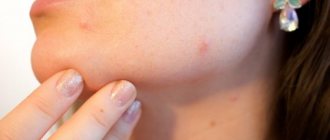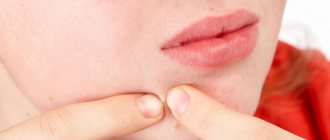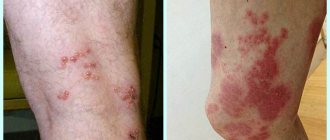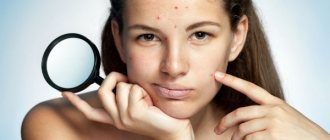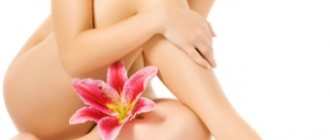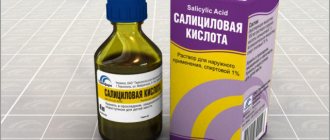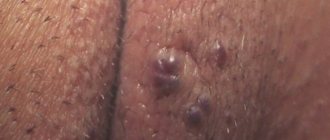The rash most often affects the face, shoulders and chest area, but this does not mean that acne on the legs is very rare. On the contrary, during certain periods of the year this problem becomes worse. All ages are subject to it, only women have to constantly wear trousers or long skirts that cover their legs because of acne. In addition to taking care of camouflage, you need to think about the reasons and try to get rid of the annoying rash.
Acne on women's legs: 6 reasons
Pimples on the legs are often not a serious problem and quickly go away on their own. But if the rash is accompanied by additional symptoms or occurs regularly, this is a cause for concern.
Dermatologists identify 6 main causes of rash on the lower extremities in women:
- Insufficient or improper hygiene. Acne appears as a result of clogged pores, which is facilitated by frequent use of body oils.
- Weakened immunity due to infectious diseases. With poor general immunity, the protective properties of the dermis are reduced. Increased growth of pathogens leads to the appearance of a rash.
- Hormonal imbalance. With an excess or deficiency of hormones, the secretory function of the sebaceous glands is disrupted. Excess sebum leads to clogging of the excretory ducts.
- Allergic reaction. The rash is accompanied by hyperemia and a feeling of irritation. Small red pimples are usually localized on the thighs and calves. Allergies can be caused by low quality foods, cosmetics and personal care products.
- Diseases of the gastrointestinal tract. When the functioning of the digestive organs is disrupted, toxins accumulate, dysbiosis and chronic constipation develop. All this affects the condition of the epidermis.
- Dermatological diseases. A small rash on the feet and palms is characteristic of dyshidrosis. With varicose dermatitis, pustules appear on the inner surface of the lower leg.
Be sure to read:
Pimples on the neck in women: the cause, which organ is not in order, how to get rid of it at home
Less common etiological factors include vitamin deficiency.
What causes rashes on feet
Acne and other pimples on the face rarely signal problems that require immediate solutions. Typically, such rashes are provoked by factors accumulated in the body: intoxication, hormonal imbalances, and so on. Changes in the quality of the dermis of the feet and toes most often manifest themselves sharply and in an acute form. And the problems that these phenomena indicate may require urgent medical intervention. Among the provoking factors are:
- infectious diseases;
- allergic reactions, dermatitis;
- psoriasis, eczema;
- cancer;
- other.
Even a person with a medical education cannot always make the correct diagnosis based on the type of rash alone. In most cases, additional laboratory tests are required.
Allergy
The most common and most harmless cause of rash on the feet in men and women is an allergic reaction. It manifests itself as an irritating factor that affects the body both from the inside and outside. When trying to figure out what caused the reaction, don't throw away products you've used before. Indeed, for allergies, the cumulative effect also becomes important, when something that previously did not cause dermatological problems can today manifest itself as a rash. There is no point in diagnosing allergies on your own. It has many faces and can masquerade as other diseases, so it is important not to confuse it with something more serious. With allergic reactions, flaky scales, red spots, blisters and papules may appear on the feet. There may be many or one or two. Itching is also not obligatory, but a possible phenomenon.
Infectious diseases
Some viral diseases manifest themselves as rashes and “pimples” on the skin of the feet and other parts of the body in the early stages. Measles, chickenpox, scarlet fever are an incomplete list of infections that are characterized by rashes on the body. And none of them can be called harmless. Therefore, it is important to diagnose the disease in a timely manner and begin treatment. Such diseases are extremely contagious and it is unacceptable to decide how to get rid of their manifestations on the advice of grandmothers and friends. Rashes with such ailments look like red blisters or papules and may itch. Most infectious diseases are characterized by an increase in temperature, a change in the color of mucous membranes, and a deterioration in general health. Therefore, rashes are not the only symptom, but one of the first to appear. It is important not to miss the moment, pay attention to it and seek help from a doctor.
Psoriasis
A disease that occurs in a chronic form, which is characterized by the formation of plaques on skin surfaces exposed to friction, bending, and squeezing. Feet and toes are also at risk. The plaques can be very small and resemble pimples, but they tend to enlarge and merge with nearby lesions. The disease is characterized by alternating acute periods with remissions, but without treatment, the duration of remissions shortens and disappears. And the affected areas increase and the severity of the disease worsens. The acute phase can be triggered by alcohol, stress and other individual factors. There is currently no treatment for this disease.
Eczema
The causes of this disease have not been clarified to this day, so it is not yet possible to cure it completely. It can be provoked by: dysbacteriosis, deficiency or excess of vitamins, malfunctions of the digestive organs, kidneys, weakened immunity and other factors. Eczema spreads, most often, on the extremities, manifesting itself first as itchy redness, and then as blisters on the affected areas. The disease has several stages and types, and each subsequent one is controlled worse and worse. Therefore, timely medical intervention is necessary. The disease most often occurs in a dry form, but sometimes a weeping form occurs, causing even greater discomfort on the feet due to watery rashes.
Some types of lichen
Psoriasis is also a representative of lichen, but there are other types of this disease that are completely different from it. These include:
- Shingles. It is characterized by an increase in temperature with significant lesions, rashes in the form of many watery blisters with cloudy contents, pain and itching in the initial stages;
- Pityriasis rosea. During this disease, spots appear on the skin and rashes in the form of blisters with a red border. Sometimes they are accompanied by slight pain, but they never merge with each other, which is typical only for this type of lichen;
- Lichen planus is a non-contagious disease. Rashes in the form of bright papules are very characteristic and do not cause difficulties for the doctor in diagnosis. After recovery, red spots remain at the site of the rash for a long time.
Each type of lichen has its own treatment, therefore, even if you suspect you have one or another type of disease, consultation with a doctor to prescribe the correct therapy is mandatory.
It is important to understand that lichen itself, and other dermatological reactions with which it can be confused, can be signals of other, more serious diseases, including various types of cancer.
Mycosis
This name summarizes several types of foot and toe diseases caused by fungi. The insidiousness of this illness is that it appears and disappears for no apparent reason, creating the illusion of recovery. The disease begins with peeling, often in the area between the fingers. Without treatment, it progresses to more severe forms, characterized by a blistering rash in the arch of the foot. Affects nails, changing their shape, structure and sometimes leading to their loss.
Scabies
A contagious disease transmitted by contact with the skin of a sick person. The disease is characterized by a red rash localized between the fingers, on the feet, in the genital area, on the wrists and other parts of the body. It is caused by the scabies mite, which moves under the skin, leaving passages in it. In the evening, microorganisms become more active, causing itching, which is difficult to ignore. Scratching “pimples” leads to secondary infection (for example, staphylococcus). In this case, the “pimples” become purulent and watery.
Whatever disease you diagnose yourself with, based on descriptions and photographs on the Internet, do not neglect going to the doctor. Especially if, in addition to rashes on the feet, other changes in the condition of the body are observed.
Acne on the thighs: causes in men
Rashes on the body bother both women and men.
The appearance of acne on the legs of men is often caused by the following factors:
- Wearing tight clothes. Tight trousers, especially those made of synthetic materials, cause irritation and impede air circulation.
- Increased sweating. Men have coarser hair on their thighs than women. With hypersecretion of the sweat glands, the skin is irritated, the hair injures it, causing inflammation.
- Contact with dirty equipment. During training, a person sweats a lot, the pores open up and quickly become clogged with dirt. Before class, you need to wipe the parts in contact with the skin.
- Abuse of anabolic steroids. Excessive levels of testosterone in the body have a number of side effects, one of which is rashes on the thighs.
- Allergy . An immunopathological reaction can be caused by washing powders, hygiene products, foods, etc.
- Stress changes the body's hormonal status, which weakens defense mechanisms.
Treatment of acne with folk remedies
Once upon a time, our grandmothers did not know any other ways to treat acne other than traditional ones. They experimented with all kinds of decoctions of medicinal herbs and prepared tinctures. Now the fashion for folk remedies is returning, because many are tired of the products of pharmaceutical companies and are drawn to natural treatment. To this day, many effective folk remedies for acne have survived:
- Juice from agave (aloe) leaves. To prepare the juice, you need to finely chop washed and dried aloe leaves. Place the resulting mass in a gauze bag and squeeze out the juice, which you use to wipe the skin daily.
- Plantain. Rinse the plantain leaves under the tap and dry. Then pass through a meat grinder and squeeze the resulting mass through a sieve. Also wipe the skin with this juice, alternating with aloe juice.
- Decoction of St. John's wort herb. Prepare the decoction according to the instructions on the box, wipe the skin twice a day.
What to do if your hands and feet itch and bumps appear?
Itchy rashes can be caused by various factors, including serious illnesses. If such symptoms appear, you should consult a specialist.
You should not scratch the pimples; small scratches allow bacteria to penetrate faster and can cause a secondary infection. The affected areas are thoroughly washed with tar or ordinary laundry soap.
Avoid contact with potential irritants - synthetic items, low-quality cosmetics. For severe itching, take oral antihistamines. Before going to bed I take a bath with a solution of potassium permanganate.
When is a visit to the doctor necessary?
Rashes on the feet are aggravated by the need to wear shoes. In winter, feet may sweat, increasing the itching; in summer, wearing open shoes increases the risk of infection. The picture can be blurry, and primary rashes can be mistaken for dropsy, abrasions, or insect bites. Therefore, remember that it is necessary to consult a doctor if you have the following symptoms:
- The rash is accompanied by fever;
- The reaction quickly spreads to other parts of the body;
- Similar signs were found in people with whom you were in direct contact;
- The resulting rashes are filled with purulent contents;
- The rash is located in a place where it is constantly injured when walking, leading to the spread of infection;
- Any rashes or acne in a child, regardless of location, must be examined by a doctor. If a rash on the foot appears in a family member with a child, then consulting a doctor is also necessary, since many diseases that manifest as rashes are extremely contagious.
Rashes on the feet, unlike acne, often indicate a progressive disease in its acute form. Therefore, self-medication is dangerous both for the sick person and for others. Treatment of such problems is permissible at home, with the permission of a doctor and strictly following his recommendations.
How to get rid of pimples on legs?
To eliminate pimples, a complex of therapeutic measures is required that can solve several problems at once:
- Eliminating the cause of the rash. A doctor should be involved in identifying etiological factors. After the examination, antibiotics and hormones may be prescribed.
- Normalization of the secretion of the sebaceous glands. Retinoids and hormones are used.
- Relief of the inflammatory process. Use pharmaceutical and natural antiseptics.
- Elimination of additional symptoms. Swelling and itching are relieved with local and oral antihistamines.
Be sure to read:
Insidious acne: causes of rashes on women's temples
To achieve a quick effect, medications and alternative cosmetic methods are used.
Drug treatment
Depending on the cause, the rash may be painful or cause no physical discomfort. If the pimples are inflamed, accompanied by itching and other symptoms, you should consult a doctor. After the examination, the specialist will prescribe symptomatic and etiotropic drug therapy.
Medicines relieve symptoms, eliminate causes and prevent relapses. Medicines other than antibiotics are available without a prescription, but medications must be prescribed by a doctor.
Therapy includes the following drugs:
- Antiseptics have antimicrobial, anti-inflammatory, local anesthetic effects (Salicylic ointment, Uroderm. Collomac).
- Antibiotics for external use: Zinerit, Klindovit.
- Regenerants help speed up the healing process and increase local immunity (Dexpanthenol, Actovegin).
- Antihistamines reduce itching and swelling (Fenistil ointment).
It is important to complete the entire course in full accordance with the specialist’s prescriptions, even if the unpleasant symptoms ceased to bother you a week after using the medications.
Cosmetological methods
Salon treatments help get rid of rashes in a short time. The most effective method for eliminating acne on the legs is ozone therapy. The technique ensures oxygen saturation of the epidermal tissue, stimulates the barrier and reparative properties of the skin.
Treating acne on legs at home
If the rash does not cause any problems other than aesthetic ones, you can try to get rid of any problems using alternative methods:
- Places of inflammation are treated with solutions and infusions based on natural antiseptics (chamomile, calendula). Sage reduces irritation and itching.
- Warm compresses help reduce inflammation and irritation. Dissolve tsp in a glass of water. salt. Gauze soaked in the solution is applied to the affected area for half an hour.
- Therapeutic baths. Twice a week I take baths with sea salt and chamomile infusion. Bay leaf decoctions help fight allergies and help remove toxins from the body.
- Using homemade scrubs has a good effect. To prepare the product, mix crushed eggshells (tbsp), soda (2 tsp), liquid sour cream (2 tbsp). The resulting composition is applied to the inflamed areas and massaged for 5 minutes.
Be sure to read:
Which organs are responsible for acne on the face and body: possible diseases
Scrubs are used no more than 2-3 times a week.
Treatment with pharmaceutical drugs
For treatment, you can and should use pharmaceuticals, but it is advisable that they be recommended by a doctor. Experts advise using Baziron gel, which has antiseptic properties and is excellent in combating skin diseases. Pindol is also considered effective - this suspension also has an astringent effect.
Lactofiltrum tablets will help remove toxins from the body and cope with acne on the arms and legs. It should be used three times a day, drinking 2 tablets at a time. The treatment course lasts at least 2 weeks.
Preventing acne on the legs
Pimples cannot be completely cured, but there are a number of recommendations that, if followed, can prevent their occurrence:
- Maintaining a healthy diet. In the diet, increase the amount of foods containing vitamins A, C, E, and omega-3. Limit consumption of animal protein. People prone to allergies are advised to adjust their diet with a specialist.
- Proper hygiene. You need to use detergents with a pH close to the skin. When using shaving machines, change the cassette before each procedure. It is good to clean the attachment on your epilator.
- Try not to wear tight pants, especially in hot weather. The training suit is washed after each visit to the gym.
- Control your time in the sun.
It is recommended to visit a dermatologist annually.
Measures to prevent diseases that cause rashes on the feet
- Some of the diseases described are autoimmune. This means that they are not contagious, and the cause of their occurrence lies within the body. Therefore, if such diseases were observed in parents, then it would be useful to be on the safe side. Learn to control your emotions, perhaps even enroll in thematic courses. Because the provocateur of such rashes is stressful situations, which are always impossible to avoid. But you can learn to respond to them without harming your health.
- Other types of diseases progress against the background of decreased immunity. Therefore, a course of vitamins in the off-season, proper nutrition, sports, healthy sleep, clean water, and the elimination of bad habits are the key to strong immunity. Even if it fails to resist the onslaught of bacteria, it will significantly ease the course of the disease.
- Elimination of allergens. An allergy is an individual reaction and can occur to any product or care product. But a number of foods, chemicals and cosmetics are known to be allergens. Avoid heavily colored and scented creams, deodorants, foot talcs and shower gels. Do not walk barefoot in places where there are aggressive chemicals. Refrain from “chemical” food and consumption of large amounts of products - classic allergens: citrus fruits, chocolate, red berries, honey.
- Treat bites, cuts, scratches—any damage to the integrity of the skin of the feet and toes—at home with antibacterial agents.
- If the disease has already taken you by surprise and the appearance of acne is accompanied by itching, trim your nails so as not to transfer the infection or fungus to healthy areas of the body.
- Give up bad habits. Provoking factors for triggering the mechanism of many autoimmune diseases are alcohol and smoking. Lack of sleep and nervous tension also aggravate the situation.
In public places (swimming pools, beaches, saunas, showers in a sports club), do not walk barefoot and do not use other people’s towels, brooms, or washcloths.
Such preventative measures will be an excellent basis for maintaining overall health. They will help prevent foot rashes and other dermatological diseases.
What kind of “beast” jumped out?
If you find a large and hard subcutaneous pimple on your leg, like a lump, then with a 99% probability you have become the happy owner of a boil. People often call it “boil” or “boil”.
Such acne appears for many reasons, but among them there are several main and most common ones:
- Hormonal imbalance is perhaps the most pressing problem. Sometimes we don’t even realize what kind of hormonal “chaos” is happening in our body in the modern rhythm of life. Stress, lack of sleep, emotions, anxiety, fatigue - all this causes changes in our hormonal levels. Now let’s think about how many of these “shifts” our body performs during at least one working week? Yes, we hope that among our readers there are many such lucky ones who can boast of a calm, measured rhythm of life without any stress. But, alas, the life of most of us, as statistics show, is one big alarm in our heads.
- Decreased immunity - a weakened body instantly responds to any damaging factor. And he doesn’t answer in the most pleasant way for us.
- Tissue damage - if there was previously a scratch or abrasion at the site where the boil formed, then there is a high probability of infection getting there.
- Poor hygiene and insufficient skin care - skin diseases are often the result of insufficient body care.
- Poor nutrition - surprisingly, it is also one of the most common causes. Too much fatty food, lack of vitamins and minerals - all this leads to a malfunction of the body and entails big problems. Unfortunately, the problem of illiterate and irrational nutrition is very relevant in our time, often due to a lack of time and necessary information, as well as the poor quality of products on the shelves.
